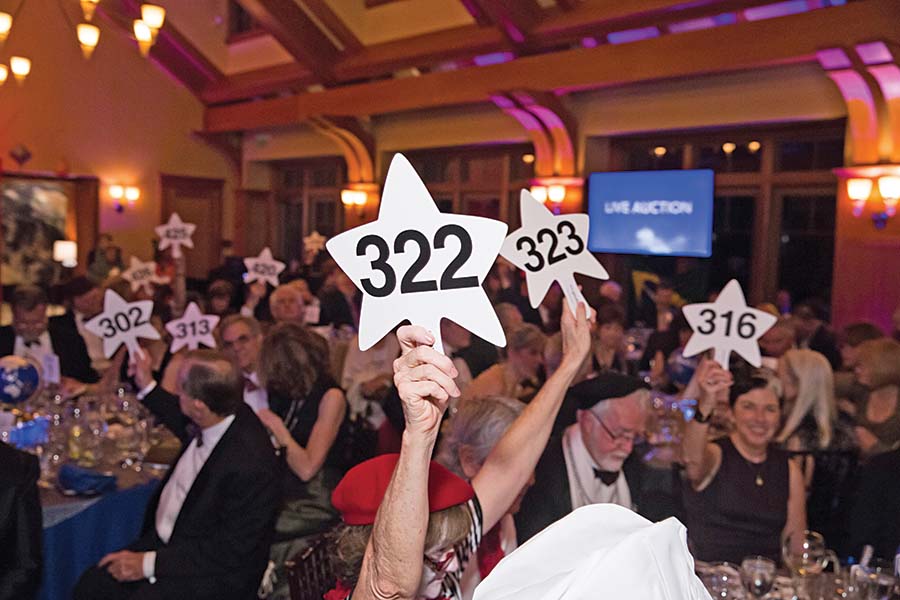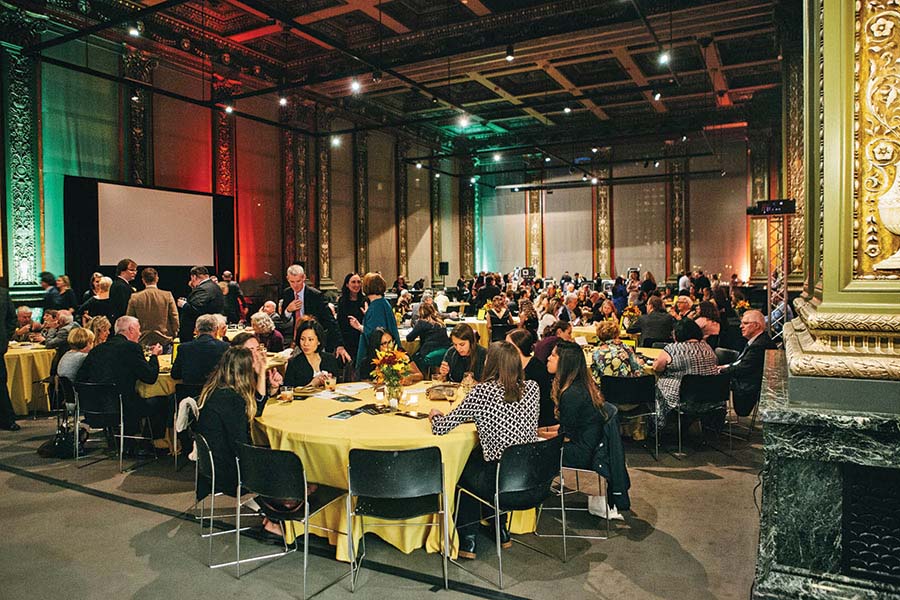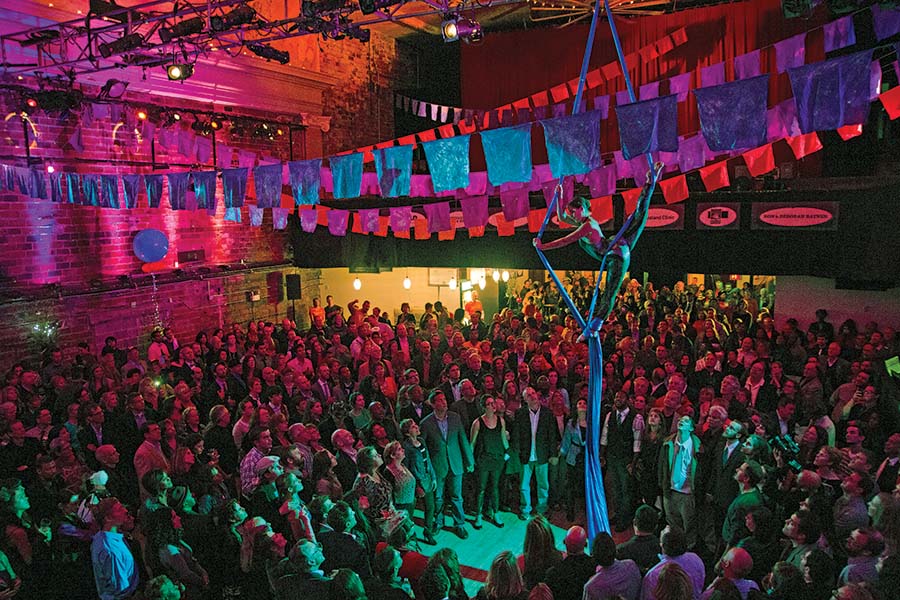Like all parties, galas typically generate a healthy dose of excitement—and more than a tinge of dread. When you’re a theatre company, your job is to literally put on a show—only this one usually includes dinner, a silent auction, text-pledging, and the bottom-line expectation of meeting a large monetary goal.
Fundraisers are a necessity for any nonprofit, and there’s an art to doing them well. But do they all have to be fancy black-tie affairs? How can theatres set themselves apart, especially in towns where “society season” can mean your major donors are juggling invites to several galas within a short time period? What’s the ideal return on investment? Is there something to be said for not having a gala at all?
Artistic and managing directors and a variety of development professionals from theatre companies around the country offered bits of advice, hard-won wisdom, and a few insider secrets to throwing a fundraising bash worthy of a standing ovation.

gala. (Devlin Shand for Drew Altizer Photography)
Don’t: Forget that you are, first and foremost, a theatre company
Galas tend to have a standard uniform: tuxedos for the gentlemen, ball gowns for the ladies, uncomfortable shoes for all. Not so at TheatreWorks in Silicon Valley, Calif. As a nod to its roots, when the company would stage original shows in parking garages, warehouses, and outdoor parks—wherever it could find a performance space—the theatre’s past galas have been held in the building’s Menlo Park scenic shop, at local tech companies, and in its rehearsal spaces. Managing director Phil Santora recalls a year when guests were encouraged to play make-believe and borrow costumes from TheatreWorks’ extensive stock, spending the night in a state of fabulous dress-up as silver-screen sirens, samurai warriors, gangsters, and Jane Austen heroines.
“Theatre galas should feel different than social service galas,” says Santora. “They can help position your organization in your town’s charitable community, yes, but they can also provide some important visibility. There are some individuals who will engage with your organization first as a gala guest, so they can serve as a point of introduction.”
Hartford Stage in Connecticut brands its gala as “not another black-tie dinner,” and when appropriate will link the event to a play in its current season. In 2018 they’ll stage a Gilded Age-themed celebration, inspired by a world premiere adaption of Edith Wharton’s The Age of Innocence, with the scene and paint shops transformed into majestic homes of Newport and New York at the turn of the 20th century.
“Our goal is to get new faces here each year,” says development events manager Jennifer Crookes Carpenter. “From members of our young professionals group, Stage One, to even the theatre departments at the nearby universities, we try to make the room diverse with those who want to celebrate Hartford Stage.”
Do: Remember that it’s okay to be weird

For the last 17 years, Cleveland Public Theatre has been hosting a blowout party whose name says it all: Pandemonium. The company’s symbol is the Greek god Pan, and that word was the inspiration for what CPT founder James Levin, along with then-artistic director Randy Rollison, first concocted in 2001 to celebrate 20 years of making theatre in Northern Ohio. Now executive artistic director Raymond Bobgan helps steer the wild evening, which he calls a “choose-your-own-adventure situation,” where guests can sample from the buffet of dance, music, theatre, and visual art that happens all over CPT’s campus.
Pandemonium was first conceived as a celebration of the company and its mission, a large part of which is to develop adventurous new work and nurture local artists. In 2017, 300 artists were accepted to perform at the extravaganza, and the application process grows more intense each year. Bobgan says the festive benefit is a chance for both artists and guests to experiment and try new things. With more than 60 performances from which to choose, a guest may encounter a band in the balcony, giant puppets outside, an art installation in a hallway, and a 10-minute play in a garage—all in the span of 20 minutes.
“We don’t call Pandemonium a gala, because it’s not one,” says Bobgan. “We just don’t think of it like that. It is just a great way to show off our artists and our artistry to a wide swath of the community who might not be theatregoers, but who believe in our impact and love a great party.”
DON’T: Focus too much on the money
The old adage “you’ve got to spend money to make money” certainly applies to galas, but most of the top brass will tell you that not only is the expense well worth it—there are always ways to cut down on costs.
“The rule of thumb I’ve always used is to contain expenses to a quarter or a third of expected revenue, but you also don’t want an event that people are spending a lot of money to attend to feel cheap,” says Elisa Spencer-Kaplan, executive director of the Acting Company in New York City. “It is okay if some details are minimal, as long as they are done thoughtfully and feel like a choice rather than a budget shortcut.
“And think twice about DIY-ing things,” she adds. “How much time will it take your staff to edit a video or create flower arrangements? Will the result feel polished and professional? In-kind contributions can be a blessing, but they often come with the strings of accepting that you may not be a top priority. Plan for more time and set realistic expectations of what someone will do for you for free or at a reduced rate.”
As Spencer-Kaplan points out, gala tickets shouldn’t come cheap. The entrance fee tends to act as a cover charge, helping to pay for the evening’s expenses. Meanwhile it’s the donations—usually in the form of silent or live auctions, sometimes in recurring contributions or even an outright check—that are earmarked for a company’s operating expenses, community outreach expansion, and education initiatives.
At the Gift Theatre in Chicago, a ticket to the 2017 gala runs an individual $150, while a buying a table sets you back $1,500 (you can also shell out $3,000 for the “VIP treatment”). Artistic director Michael Patrick Thornton, managing director John Gawlik, and board chairman Laura Gale report that their yearly gala tends to cost about $22,000, while the net revenue the past few years has been around $40,000-$45,000.
“We use the night to highlight a supporter of ours who exemplifies Gift values, and our ensemble gets a chance to spend time with the people who help make all this possible,” says Thornton. “As a small storefront with a tiny lobby, there’s unfortunately little opportunity at the Gift for interaction beyond the play. Events like the gala help us create those opportunities and memories.”
Hartford Stage’s gala currently has a fundraising goal of a quarter of a million dollars, with tickets starting at $300 for an individual and going up to $6,000 for a benefactor’s table of eight. In 2016, Cleveland Public Theatre’s Pandemonium grossed around $375,000 (including the value of in-kind gifts), though it has a twist on the traditional night-of format where the actual money is concerned.
“We don’t ask for any money at the event itself—it’s all raised in advance,” says Bobgan. “At this point, even if we didn’t raise funds we would still probably do it. It’s part of our mission. It’s a platform and forum for artists to develop new work.”
One place you shouldn’t skimp: funds for performers. “They will remember it,” cautions Spencer-Kaplan, “and they will tell others. Give your performers something nicer than a sandwich.”

Do: Lean on the people who want to be there
“Volunteers will give you more love than most low-wage catering servers,” says Bobgan, explaining Pandemonium’s practice of using volunteers to work the party. Serving the food and drink (also donated) is a way for 100 volunteers to score entry to the hot-ticket event—and once their duties are done they’re free to take part in the revelry. While not every company can rely on this tactic, you’d be wise to accept and embrace the enthusiasm of those who are willing to give it.
“One real key to a successful gala is the ownership of the committee,” says Santora. “The more they invest their passions and partner with the theatre on creativity, the more that energy will permeate the event. We also find it important to listen to gala attendees and table hosts about what they are looking for in an event, so that everyone is on board and excited. With this kind of input and personal investment we make sure that the event is elevated from a same old meal-speeches-auction obligation event—because who wants to attend another one of those?—to a great big, rollicking fun party, a joyful celebration of what TheatreWorks Silicon Valley is all about.”
Don’t: Force people to come
Just as the holiday season begins ramping up in November, Chicago’s Theatre Wit provides the solution to everyone who just needs a night off: its Stay At Home Gala. As its name promises, the Stay At Home Gala encourages guests to enjoy a night in, complete with prizes like a gourmet meal delivered directly to their door, live-streaming of speeches and sneak-peek performances from the company’s upcoming season, bartenders offering cocktail tips, and a secret link to the live auction. And it might just be the only gala to which your choice of wardrobe ranges from cocktail dress to sweats.
Do: Give your audience a show
Big names tend to bring in the big bucks, no question. But the impact is even greater when the stars have a personal connection to the organization.
“TheatreWorks has become a nurturing haven for playwrights, composers, and lyricists from across the country,” says Santora. “We have been delighted to have many offer to return and host, or even create original songs for our events,” including Wendy Wasserstein, Stephen Schwartz, Andrew Lippa, and James Monroe Iglehart.
Dallas Summer Musicals had Bernadette Peters lined up for its 2017 gala, titled “The Best of Broadway”—but then she accepted the offer to replace Bette Midler in Hello, Dolly! Instead of panicking, the development team secured a pair of high-caliber replacements in singer/actress Katharine McPhee (of “Smash” fame) and two-time Tony winner Brian Stokes Mitchell. Even with McPhee joking during her performance, “I’ve never actually been on Broadway, so you should all get your money back,” the company went on to break its previous fundraising record by raising $500,000.
But a starry lineup isn’t a necessity. Theatre companies already have a wealth of talent waiting in the wings, and audiences often thrill at the opportunity to nosh and joke with local luminaries.
“There is a great synergy that emerges when someone with a genuine tie to the honoree or the company speaks or performs,” says the Acting Company’s Spencer-Kaplan. “The difference is palpable, and can make for some truly magical moments.”
One board member of the Gift Theatre, for instance, is part of the jazz ensemble Blaze Triptych, which has provided entertainment in years past. Award-winning sound designers make fantastic DJs, the company has found, and a brief scene or sketch from the theatre’s ensemble is always well received.
“Sometimes throwing a gala seems like a lot of fuss and bother (and expense!) when you have limited resources and energy and might prefer to focus on making great theatre,” says Spencer-Kaplan. “I’m sure we all sometimes wish our patrons would just write a check and be done with it. But I actually love the chance a gala brings to provide public recognition of people who are doing good in the world. And pragmatically, there is always a group of patrons who will attend a gala who you might have a hard time engaging otherwise. It is a great platform to spread the message about your good work to a new audience, and to bring together people from different areas of your organization who might not have a chance to interact otherwise. Artists and donors, staff and young patrons, board members and that new person who came as someone’s date all get to mix and mingle.”
At the end of the 2016 Pandemonium, Bobgan recalls standing on a chair in the center of the room, surrounded by a raucous circle of singing and dancing performers and guests, when a donor climbed onto a chair next to him. “I had to grab her hand,” he says. “Imagine that: standing on a chair next to a donor, holding her hand, and watching the action. You can literally see the needle moving, see people changing how they think and feel about other people. Every year we see people who didn’t know each other before or may not have otherwise met, deciding what they’re going to go see together next.”
Lindsey Wilson is an arts writer and critic based in Dallas.


